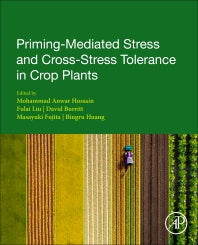Freshly Printed - allow 10 days lead
Couldn't load pickup availability
Priming-Mediated Stress and Cross-Stress Tolerance in Crop Plants
Helps readers develop strategies to enhance crop productivity under stressful conditions and better utilize natural resources to ensure future food security
Mohammad Anwar Hossain (Edited by), Fulai Liu (Edited by), David Burritt (Edited by), Masayuki Fujita (Edited by), Bingru Huang (Edited by)
9780128178928, Elsevier Science
Paperback, published 21 January 2020
362 pages, 40 illustrations (30 in full color)
23.4 x 19 x 2.3 cm, 0.76 kg
Priming-Mediated Stress and Cross-Stress Tolerance in Crop Plants provides the latest, in-depth understanding of the molecular mechanisms associated with the development of stress and cross-stress tolerance in plants. Plants growing under field conditions are constantly exposed, either sequentially or simultaneously, to many abiotic or biotic stress factors. As a result, many plants have developed unique strategies to respond to ever-changing environmental conditions, enabling them to monitor their surroundings and adjust their metabolic systems to maintain homeostasis. Recently, priming mediated stress and cross-stress tolerance (i.e., greater tolerance to a second, stronger stress after exposure to a different, milder primary stress) have attracted considerable interest within the scientific community as potential means of stress management and for producing stress-resistant crops to aid global food security.
Priming-Mediated Stress and Cross-Stress Tolerance in Crop Plants comprehensively reviews the physiological, biochemical, and molecular basis of cross-tolerance phenomena, allowing researchers to develop strategies to enhance crop productivity under stressful conditions and to utilize natural resources more efficiently. The book is a valuable asset for plant and agricultural scientists in corporate or government environments, as well as educators and advanced students looking to promote future research into plant stress tolerance.
1. Priming mediated stress and cross-stress tolerance in plants: concepts and opportunities 2. Plant physiology and Molecular Mechanisms in Cross-regulation of Biotic-Abiotic Stress Responses 3. Getting ready with the priming: Innovative weapons against biotic and abiotic crop enemies in a global changing scenario 4. H2O2-retrograde signaling as a pivotal mechanism to understand priming and cross stress tolerance in plants 5. Induced resistance to biotic stress in plants by natural compounds: Possible mechanisms 6. Induction of plant resistance to biotic stress by priming with ß-aminobutyric acid (BABA) and its effect on nitrogen-fixing nodule development 7. Drought stress memory and subsequent drought stress tolerance in plants 8. Reactive nitrogen species mediated cross-stress tolerance in plants 9. Drought priming-induced heat tolerance: Metabolic pathways and and molecular mechanisms 10. Heat shock induced stress tolerance in plants: Physiological, biochemical and molecular mechanisms of acquired tolerance 11. Heat priming induces intra- and trans-generational thermo-tolerance in crop plants. 12. Induction of cross tolerance by cold priming and acclimation in plants: Physiological, biochemical and molecular mechanisms 13. Roles of reactive oxygen species in modulating cross tolerance in plants via flavonoids 14. Hydrogen sulfide: A novel signaling molecule in plant cross-stress tolerance 15. Plant transcriptional regulation in modulating cross-tolerance to stress 16. Molecular mechanisms regulating priming and stress memory 17. Abiotic and biotic stress interactions in plants: A cross-tolerance perspective 18. Seed priming-induced physiochemical and molecular events in plants coupled to abiotic stress tolerance: An overview 19. Cross-tolerance to abiotic stress at different levels of organizations: Prospects for scaling-up from laboratory to field
Subject Areas: Plant physiology [PSTD], Botany & plant sciences [PST], Molecular biology [PSD], Biochemistry [PSB]


